Rotator cuff surgery in Burr Ridge
Also serving Plainfield, Morris and surrounding areas
| Procedure | • Arthroscopic, Outpatient • The torn rotator cuff is sutured back into its normal position using the scope |
| Duration | 1.5 hours–2 hours |
| Anesthesia | General |
| Recovery | • Recovery will vary depending on the size of the tear 4–6 months • Return to work will depend on type of work • Return to sports will vary from 4 months to 8 months depending on age and type of sport |
Rotator Cuff Surgery
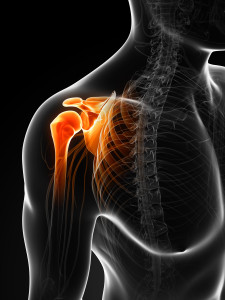
Most patients with complete tears will require surgical re-attachment of the torn rotator cuff muscle. The rotator cuff is like any other muscle in the body. When it is torn or detached from its normal position, it will atrophy (shrink) and will not function properly. The rotator cuff once torn does not heal on it’s own. Rotator cuff surgery is performed as an outpatient procedure and is done in a minimally invasive fashion using the arthroscope and 1cm incisions. Rehabilitation after surgery is dependent upon the amount of damage repaired and may last from 3–6 months.
Non-surgical treatment of the Rotator Cuff
Treatment will depend on the severity of injury. In the case of a partial tear or injury to the rotator cuff, many patients will improve with a directed physical therapy program alone.
More about Rotator Cuff Injuries
The rotator cuff is a group of muscles deep in the shoulder joint that provide motion for the ball and socket and help to maintain the stability of the joint. Injury to the rotator cuff is painful and may cause dysfunction of the shoulder, especially with overhead movement. Causes for injury may include falls, throwing injuries, repetitive activities, and overhead lifting activities.
The rotator cuff is comprised of the following muscles: Supraspinatus, Infraspinatus, Subscapularis, and Teres Minor. Together this group of muscles holds the ball into the socket. The most common muscle to tear is the Supraspinatus. It becomes detached from the ball of the shoulder joint and causes pain and lack of normal movement for the shoulder. The pain will generally travel down from the top of the shoulder along the upper /outer arm. The pain will be worse when reaching or overhead movement and typically will cause difficulty with sleep. Some tears are only Partial and, in essence, frayed, but not completely separate from the ball. Many of these can be treated with non-invasive treatment such as physical therapy, medication and sometimes injections. Complete tears indicate a separation of the muscle from the ball and these typically require surgery.
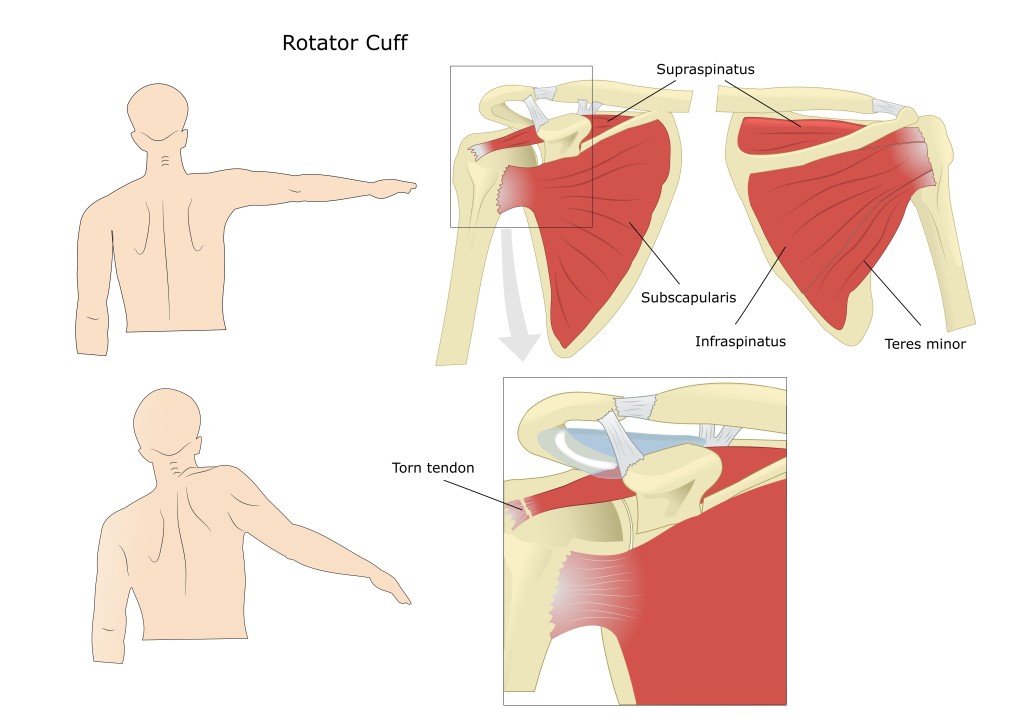
Rotator Cuff Surgery Recovery
Recovery Timeline
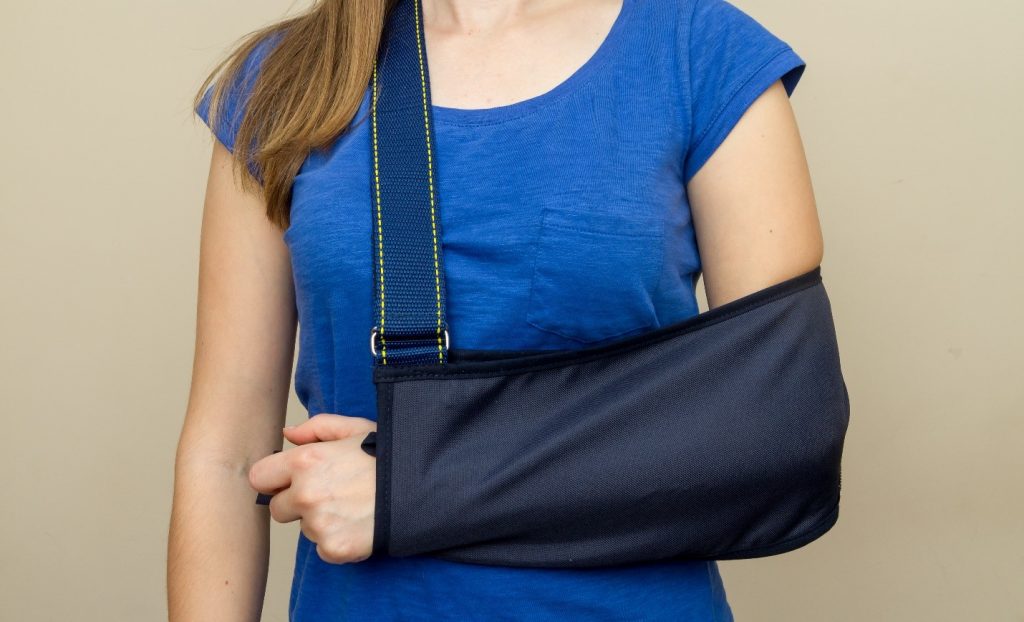
- Post Op Day 1-7: Patients will feel fatigued and sore for the first few days after surgery.
- Post Op weeks 1-2: Patients feel well enough to resume routine activities while following precautions and avoiding any use of the surgical arm. Patients may return to work 7-10 days post-operatively if their job is sedentary and not physical.
- Post-Op week 6: Most patients will be able to start performing light activity in a typical routine using the surgical side. Patients should be aware of soreness and limit over-use to maintain the integrity of the surgical repair and ensure appropriate healing continues to progress.
- Post Op Month 3-4: Dependent on severity of Rotator Cuff pathology and surgical approach, patients can expect to begin returning to Prior Level of Function without significant limitation in this phase of recovery. Complete recovery, retraining strength and endurance, and pain free end range of motion will be achieved in this phase while the patient is resuming normal activity.
Managing Pain
- The anesthetic nerve block injection typically begins to wear off 18-24 hours after surgery, patients can expect to experience pain and post-operative soreness. The level of pain varies from patient to patient and type of surgery.
- Dr. Burt will prescribe pain medication to help patients control their pain. Please take this medication as instructed and prescribed for best management of pain.
- The use of ice is important in managing inflammation post-surgically. Patients can place an ice pack on the involved shoulder to control edema and help manage discomfort. Please note: Provide a barrier like a towel or pillowcase with the ice pack to prevent incision site from exposure to moisture, and ice can be used for 20 minutes at a time 4-5 times per day.
Wearing a Sling
- The appropriate use of a sling is critical in the healing process to protect the integrity of the repair and allow for necessary healing and recovery.
- Patients should wear their sling at all times as instructed by their Surgeon for the first 6 weeks. You may carefully remove your sling for bathing. The Surgeon and your Physical Therapist will partner to prepare for you to wean from your sling when appropriate.
- It is especially important to wear the sling when in an upright or standing position because that is when the arm is most likely to swing — even involuntarily — and impede recovery.
Sleeping
- Sleep is a core component in the body’s healing process. Beyond napping in the initial days after surgeries, patients should commit to getting quality sleep each night in the months to follow surgery to ensure a progressive recovery.
- The ideal sleep position while recovering from rotator cuff surgery is on the back in either a reclining chair or on a bed with multiple pillows propping up the head and shoulder.
- Keeping the involved shoulder elevated over the rest of the body should help to minimize swelling and discomfort, and this is where pillow propping is key.
Physical Therapy
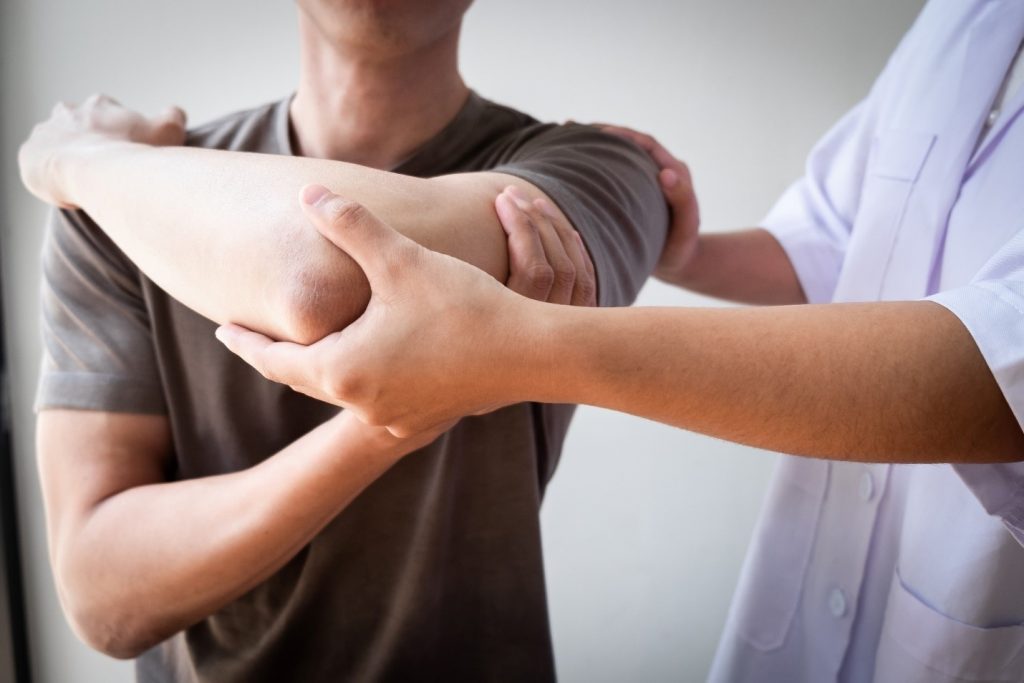
- Physical therapy is necessary in the early post-surgical phases through return to normal activity. Therapists will address pain, range of motion, posture, strength, coordination, and endurance based on the protocols established by your Surgeon. Consistent attendance in Physical Therapy is an important piece of a patient’s successful recovery.
- It is important to learn the necessary exercises (as well as the pace at which to perform these exercises) while under supervision of a Physical Therapist so as not to aggravate the rotator cuff. Once patients have these exercises down, they can incorporate them into their Home Exercise Program.
- Limit physical activity and obeying post-operative precautions as advised by your Physical Therapist. Walking (with a sling on) is a healthy alternative to more strenuous forms of exercise since it increases blood circulation without putting a strain on the shoulder.
Rotator Cuff Surgery Results
- Most patients will regain a normal range of motion in their shoulder after approximately 4 months. It’s important to note that individuals heal differently, and the amount of damage found and treated at the time of surgery are all things that will affect healing time and end result.
- Follow-up studies find that roughly 90% of patients who undergo rotator cuff surgery have a successful recovery and are pleased with their results.
Types of Rotator Cuff Tears
Rotator cuff tears vary in type based on several factors:
- Partial-thickness tears affect only a part of the tendon and do not go all the way through.
- Full-thickness tears extend through the entire tendon, potentially creating a hole.
- Acute tears are caused by sudden, specific injuries such as lifting heavy objects or suffering a fall.
- Degenerative tears develop gradually over time and are typically the result of aging or repetitive stress on the shoulder.
- Articular-side tears occur on the side of the tendon that faces the shoulder joint.
- Bursal-side tears happen on the upper side of the tendon, which is opposite the joint.
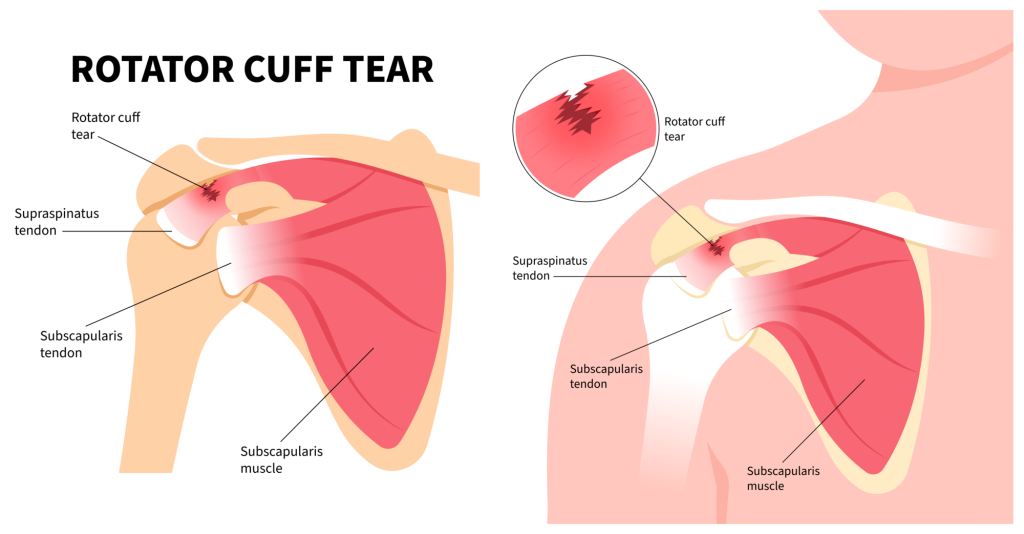
Symptoms of Rotator Cuff Tears
Symptoms of rotator cuff tears can vary depending on the severity and type of the tear, but generally include:
- Pain is often the initial symptom, especially when lifting the arm or moving it in certain ways. Pain might also be more noticeable during the night or when lying on the affected shoulder.
- There may be a significant reduction in the strength of the shoulder, making it difficult to perform overhead activities or lift objects.
- Patients might have limited range of motion, finding it hard to reach behind the back or perform movements that involve raising the arm.
- The shoulder area may swell and become tender to the touch.
- Some individuals may hear popping or cracking noises when they move their shoulders.
These symptoms can impact daily activities and overall quality of life, highlighting the importance of seeking medical evaluation and treatment.
Potential Causes of Rotator Cuff Tears
- Repeated use of the shoulder for overhead activities can strain and tear the rotator cuff muscles and tendons over time.
- Sudden injuries from activities like lifting heavy objects or falling on an outstretched arm can cause tears.
- As we age, the tendons of the rotator cuff can deteriorate, making them more susceptible to tears.
- Reduced blood flow to the rotator cuff area can impair tissue health and repair, leading to tears.
- Bone spurs: can develop on the underside of the shoulder blade and rub against the tendon, gradually wearing it down.
Rotator Cuff Tear FAQs
How common are rotator cuff tears?
About 2 million people in the United States experience a rotator cuff tear each year, requiring a trip to their doctor. While people of any age may have these injuries, older adults are the most at risk. Rotator cuff tears may affect more people than we realize because some patients may have no symptoms until the injury worsens.
Are rotator cuff injuries more difficult to treat in older people?
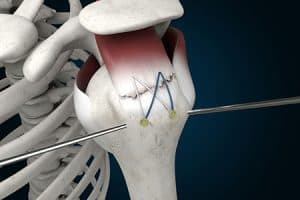
People over 40 are more likely to develop a degenerative rotator cuff tear because the tendon wears down with long-term use and natural aging. Bone spurs may form on top of the shoulder bone as you age, creating shoulder impingement and friction between the bone and tendon when the arm is lifted, possibly leading to a rotator cuff tear. This population is more at risk because blood flow decreases with age, and a tendon is more likely to tear when the tissues and muscles don’t have a healthy blood flow.
Rotator cuff tears in elderly patients can be more challenging to treat than in younger patients because these patients are more likely to re-tear the tendon. Dr. Burt may or may not recommend surgical repair for seniors, depending on these factors:
- Tissue quality
- The degree of the tear
- Post-surgery risks
- Re-tear risk
- Patient’s goals
- Quality of life
- Overall health
Healthy elderly patients without significant comorbid conditions who wish to return to their active lifestyles can still benefit from rotator cuff repair to minimize pain, restore range of motion, and regain previous shoulder function.
What does a rotator cuff tear feel like?
Each patient may experience the discomfort and sensations of a torn rotator cuff differently. Some may have a deep, dull ache in their shoulder, while others report a stabbing feeling like a knife is cutting into their shoulder. Sudden rotator cuff tears, like from an auto accident, typically cause immediate, intense shoulder pain and arm weakness. Degenerative tears occur gradually and may begin with minimal discomfort that’s easily masked with over-the-counter pain medicines but worsen over time. Some patients may not feel pain or discomfort but have arm and shoulder weakness.
Am I at risk for a rotator cuff tear?
While anyone may experience a rotator cuff tear, people with these risk factors are more likely to suffer the injury:
- Family history of shoulder problems
- History of smoking
- Aged 40 or older
- Poor posture
Degenerative rotator cuff tears are more common in professions requiring repetitive shoulder movements, including painting, carpentry, and mechanics as well as professional or recreational sports such as tennis, softball, baseball, or rowing.
How much does rotator cuff repair surgery cost?

Complete rotator cuff tears require surgery to reattach the torn muscles and tendons. The cost of your procedure relies on many factors and is subjective because prescriptions, rehabilitation aids, imaging tests, and the facility could drastically change the price. You are responsible for co-pays and deductibles through your insurance. Patients may sign up for a payment plan to cover their portion of the surgical costs and rehabilitation services with affordable monthly payments.
How is a rotator cuff tear diagnosed?
- Patient History and Physical Examination: The diagnosis often begins with a detailed discussion of symptoms and a physical exam where the doctor checks for pain points and the range of motion in the shoulder.
- Imaging Tests: X-rays may be used to rule out bone-related issues, while an MRI is more effective for viewing the soft tissues, including the extent of the tear.
- Ultrasound: This imaging method is sometimes used as it allows real-time evaluation of the rotator cuff and can assess dynamic function.
- Arthroscopy: In some cases, this surgical technique may be employed for a more direct visual and physical examination of the rotator cuff.
These diagnostic tools help to confirm the presence of a tear and its characteristics, which guide the treatment plan.
How can I prevent a rotator cuff tear?
- Strengthening the muscles around the shoulder with regular exercise can provide better support and reduce the risk of tears.
- Allowing time for rest and recovery between intense activities can prevent overuse injuries.
- Modifying your workspace or sports equipment to support correct posture and movement can reduce strain on your shoulders.
- Incorporating a routine of warming up and stretching before activities can improve flexibility and reduce the chances of injuries.
Schedule an Appointment Today
As a premier Naperville orthopaedic surgeon, Dr. David Burt understands the pain and discomfort that can be caused by a rotator cuff tear. He is committed to providing patients with the most advanced treatments available, to help them recover and resume their active lifestyle. Other shoulder injuries that Dr. Burt treats include shoulder dislocations and labral tears. To schedule a consultation at the Midwest Sports Medicine Institute, contact our Burr Ridge office by calling (630) 455-2000, our Plainfield office at (815) 267-8825, or our Morris office at (815) 941-1885.
Recent posts
Lateral Decubitus Position for Arthroscopic Suprapectoral Biceps Tenodesis

The purpose of this report is to describe arthroscopic suprapectoral biceps tenodesis in the lateral decubitus position. Many technique descriptions for this procedure emphasize the beach-chair position to obtain optimal anterior subdeltoid visualization of the relevant anatomy. This is not...
Read MorePhysician's corner: Dr. David Burt

Two years ago, Dr. David Burt opened up his third clinic with Midwest Sports Medicine Institute in Burr Ridge. Along with locations in Plainfield and Morris, Dr. Burt is able to treat countless of athletes of all ages and levels...
Read More
